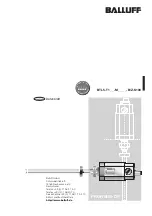
© 2017 Jackson Labs Technologies, Inc.
27
RSR GNSS Transcoder™ User Manual
consistently track the SV32 signal because this satellite is not part of the normal GPS constellation.
If this is the case, then the HIGHEST holdover indicate mode can be used instead.
In the HIGHEST holdover indicate mode the unit decreases the RF signal amplitude of the highest
elevation satellite by 6dB to indicate that the holdover state is active. This difference in signal
strength can be easily distinguished in the target receiver’s reported SNR numbers since the highest
elevation satellite will have a reported SNR signficantly below the average reported for other
satellites. In most cases, the target receiver can continue to use this satellite in the PVT solution.
However, the accuracy of the PVT solution may be affected due to the reduction in signal strength of
one satellite.
When the external GNSS receiver obtains a GPS fix, the transcoded position quickly moves within
defined maximum dynamics to the new input position and the time will quickly skew to the precise
time obtained by the input 1PPS. See Section
for the commands that control the maximum
dynamics that are applied to the RF simulator output when the position has to be “jumped” from one
second to the other such as would happen when the external reference GNSS receiver has re-aquired
a PVT fix after a longer GNSS-denied period.
OFF mode:
The off mode will cause the RF output to turn off within about 4 seconds of the external
GNSS receiver losing valid position data. When this happens, the target GPS receiver will also lose a
GPS lock so that the timing holdover performance depends upon the characteristics of the target GPS
receiver system. This mode also guarantees that the target receiver will not output invalid PVT data
since it will indicate that no GPS fix is available. When the external GNSS receiver obtains a GPS
fix, the transcoded position will move immediately to the new input position and the time will jump
to the precise time from the external 1PPS reference, or from the internal oscillator when no 1PPS
reference is present. This mode is typically only used with the TCXO variant of the module, as the
CSAC time and phase information would not be available to a target GPS receiver when the module
goes into holdover/flywheel mode.
LIMIT mode:
The LIMIT mode will cause the transcoded RF output to remain on for a defined
length of time after the external GNSS receiver indicates loss of valid position data. The holdover
time limit is configured using the SIMulation:HOLDover:LIMIT command as described in
Section
. When the holdover limit has been reached the RF output turns off and the target
receiver will lose its GPS lock. The LIMIT mode is useful when the holdover timing stability of the
RSR GNSS Transcoder™ should be used for a limited time to prevent excessive timing errors from
being transfered to the target receiver. When the external GNSS receiver once again indicates valid
PVT data, the RSR GNSS Transcoder™’s holdover recovery behavior will be similar to the ON
holdover mode if the RF output was still enabled at the time the holdover ended, and it will be similar
to the OFF holdover mode if the RF output had already been disabled due to reaching the holdover
time threshold limit. This could be losely compared to a GPS cold- and warm-start.
3.8.2 Detecting and Configuring External GNSS Receiver
In addition to accepting standard NMEA input from the external GNSS receiver, the RSR GNSS
Transcoder™ can also control special functions on Rockwell Collins RSR SAASM Puck and
Microgram SAASM GPS receivers as well as uBlox 5 through uBlox 8 GPS/GNSS receivers through
serial configuration data sent from the RS-232 port to the external GNSS receiver. The type of
receiver is configured with the GPS:TYPE command as described in Section
. The default
configuration is AUTO where the receiver type is automatically queried and detected after power-on
or reset. The following sections describe the special configuration and monitoring features available
with the Rockwell and Ublox receivers.
Содержание RSR GNSS Transcoder
Страница 1: ...RSR GNSS Transcoder User Manual Document 80200553 Version 1 1 Date 13 September 2017...
Страница 2: ...RSR GNSS Transcoder User Manual Copyright 2017 Jackson Labs Technologies Inc...
Страница 9: ...2017 Jackson Labs Technologies Inc vii RSR GNSS Transcoder User Manual 7 1 3 Exclusive Remedies 118...
Страница 10: ...RSR GNSS Transcoder User Manual viii 2017 Jackson Labs Technologies Inc...
Страница 20: ...RSR GNSS Transcoder User Manual 10 2017 Jackson Labs Technologies Inc...
Страница 110: ...RSR GNSS Transcoder User Manual 100 2017 Jackson Labs Technologies Inc...
Страница 126: ...RSR GNSS Transcoder User Manual 116 2017 Jackson Labs Technologies Inc...
















































